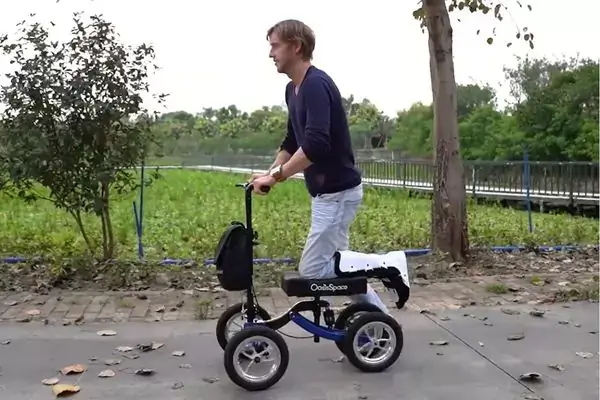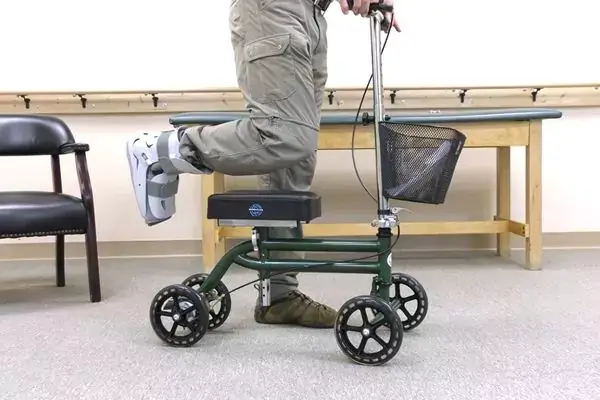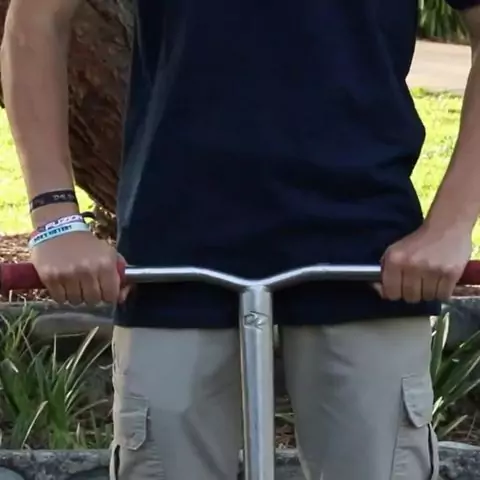How to make a knee scooter more comfortable? You can make your mobility on a knee walker a lot more comfortable by following the tips we’re sharing here.
One thing that you can do is adjust the seat. Most knee scooters have adjustable seats, so find the right position that is comfortable for you. You can also add padding to the seat. You can purchase special cushions designed for knee scooters, which is better than a pillow or cushion.
Finally, make sure that you’re using the walker correctly. Don’t forget to find the best knee scooter pads recommendations below.
Contents
- 1 Key Takeaways
- 2 7 Tips to Make your Knee Scooter More Comfortable
- 3 Knee Scooter is Killing My Knee: How to Reduce Strain?
- 4 Knee Scooter Non Weight Bearing
- 5 Knee Scooter With Walking Boot
- 6 How High Should the Knee Pad Be on a Knee Scooter?
- 7 Is a Knee Scooter Easier Than Crutches?
- 8 FAQs
- 9 Final Thoughts
Key Takeaways
- Adjust your knee walker to fit your height.
- First, adjust the handles. The actual handle adjustment would make a 15 to 20-degree angle to the elbow when you ride the walker. An easy to ensure this is the hand grip has to be even with your wrist when you’re standing.
- Then, adjust the knee rest. It should be even with the bottom of your knee at a 90° angle when you’re standing.
- Next, check the hand breaks. Make sure they’re working before you start riding.
- Now, you can use the knee walker just like a scooter.
- To transport easily, remove the basket and keep the handlebars folded back.
7 Tips to Make your Knee Scooter More Comfortable
- Add a seat pad.
- Add a gel pad for additional cushioning.
- Get a knee scooter with armrest for more comfortable.
- wear socks with a grip so you don’t slip.
- Get a lightweight knee scooter easy to carry.
- Use soft breaks while riding.
- Check your knee scooter parts before start riding.
Knee Scooter is Killing My Knee: How to Reduce Strain?
This can put extra strain on your knees and cause further damage. In addition, the repetitive motion of using a knee scooter can also lead to additional pain and irritation in your joints. If you’re considering using a knee scooter, be sure to talk to your doctor first. They can help you weigh the risks and benefits and determine if it’s the right choice for you.
If your knee scooter is causing knee pain, there are several ways to reduce strain and increase comfort:
Proper Adjustment
- Adjust the Height: Ensure the knee platform is set at the correct height, so your leg forms a 90-degree angle when resting on the platform. This alignment helps distribute your weight evenly.
- Check Handlebar Height: The handlebars should be at a comfortable height to avoid bending or hunching over, which can cause additional strain on your knee and back.
Enhanced Padding
- Add Cushioning: Use additional padding or a cushioned cover on the knee platform to provide extra support and reduce pressure on your knee.
- Gel Pads: Consider using gel pads or memory foam cushions designed for knee scooters for maximum comfort.
Knee Scooter Non Weight Bearing

When you have an injury or surgery to your leg, ankle, or foot, doctors usually recommend that you keep weight off of the affected area. This can be difficult to do, especially when walking is painful or impossible. A knee scooter is a great solution for getting around while keeping weight off of your injured leg.
A knee scooter is a small platform on wheels that you rest your knee on and propel yourself forward with your good leg. They are easy to use and maneuver and can be a big help when recovering from an injury. Many people find that using a knee scooter is more comfortable than crutches, and they also allow you to get around much more easily.
If you are considering using a knee scooter during your recovery, there are a few things to keep in mind. First, make sure to follow your doctor’s instructions regarding weight bearing and activity level. Second, practice using the scooter in a safe area before taking it out in public.
And finally, be sure to wear proper footwear – closed-toe shoes are best to avoid any accidents. Using a knee scooter can be a great way to stay mobile while healing from an injury. Just be sure to follow your doctor’s orders and take some time to get used to the scooter before venturing out into the world!
Knee Scooter With Walking Boot
If you’ve recently injured your foot or ankle, you may be wondering if a knee scooter is a right choice for you. If your doctor has placed you in a walking boot, it’s actually a great option! Here’s everything you need to know about using a knee scooter with a walking boot.
First, let’s talk about why using a knee scooter can be beneficial when you’re wearing a walking boot. For one, it will take pressure off of your injured foot or ankle, which will help reduce pain and swelling. Additionally, using a knee scooter can help speed up your recovery time by allowing you to get around more easily while still keeping your injury immobilized.
Now that we’ve gone over the benefits of using a knee scooter with a walking boot, let’s talk about how to use one safely and effectively. First and foremost, make sure to follow all of your doctor’s instructions regarding weight bearing on your injured foot or ankle. Once you have the green light from your doctor, slowly place the booted leg onto the platform of the knee scooter and adjust until you find a comfortable position.
When riding the scooter, always keep your good leg slightly bent to avoid putting too much pressure on your injured leg. Finally, make sure to practice braking and turning before going full speed – this will help prevent falls and further injuries. By following these tips, using a knee scooter with a walking boot can help make life with an injury much easier!
How to Use the Bathroom With a Knee Scooter?
If you are someone who has had to use a knee scooter for an extended period of time, you know that one of the most difficult things to do is use the bathroom. Here are a few tips on how to make this process a little easier.
1. Find a bathroom that is large enough to accommodate your knee scooter, even if it’s a public restroom.
2. Once you have found an appropriate bathroom, position your knee scooter in front of the toilet so that you can easily transfer onto it.
3. If possible, have someone else help you with transferring onto the knee scooter and then holding it steady while you use the restroom. If not, be very careful when transferring onto and off of the knee scooter as you do not want to fall and injure yourself further.
4. When finished using the restroom, carefully wash your hands and then transfer back onto your knee scooter.
How High Should the Knee Pad Be on a Knee Scooter?

If you’re considering using a knee scooter to help you move around while recovering from an injury or surgery, one of the first things you’ll need to figure out is how high the knee pad should be. The answer may not be as simple as you think. Here are a few things to keep in mind when setting the height of your knee scooter’s knee pad:
1. The height of the knee pad should be set so that your injured leg is at a 90-degree angle when using the scooter. This will ensure that your leg is getting the proper support and alignment it needs.
2. The height of the knee pad can also be adjusted based on how much weight you’re putting on your injured leg. If you find that you’re putting more weight on your good leg, you may need to raise the height of the knee pad so that your injured leg isn’t bearing too much weight.
3. You’ll also want to make sure that the knee pad is positioned correctly for your body type and size. If you’re taller or have longer legs, you may need to raise the height of the knee pad so that it’s in line with your hips and waist.
Conversely, if you’re shorter or have shorter legs, you may need to lower the height of the knee pad so that it doesn’t come up too high on your thigh.
Is a Knee Scooter Easier Than Crutches?

If you’ve ever had to use crutches, you know that they can be quite cumbersome and difficult to maneuver. Knee scooters, on the other hand, are much easier to use and provide a more stable platform for mobility. Here’s a closer look at the two options to help you decide which is best for you:
Crutches: Crutches require the use of your hands and arms for support and balance. This can be tiring, especially if you have to use them for extended periods of time. They also require a certain amount of upper body strength to maneuver, which some people lack. In addition, crutches can be slippery on wet surfaces and can be difficult to navigate stairs with.
Knee Scooter: A knee scooter is a four-wheeled device that supports your injured leg while allowing you to move around relatively easily with the good leg. You simply rest your knee on the padded knee platform and push off with your good leg just like you would when walking normally.
Knee scooters are much easier to control than crutches and provide a more stable base of support, making them ideal for those who lack upper body strength or coordination. They’re also great for indoor use as they won’t slip on wet floors like crutches can.
How Do You Pad a Knee Scooter?
If you are using a knee scooter for the first time, you may be wondering how to pad it properly. Here are some tips on how to pad a knee scooter:
1. Place the knee scooter on a flat surface and make sure that the brakes are engaged.
2. Place a pillow or other soft padding on the seat of the knee scooter.
3. Put your injured leg on the padded seat and strap your leg in place with the provided straps.
4. Make sure that your good leg is placed firmly on the ground before you start moving around on the knee scooter.
FAQs
How Do I Stop My Knee Scooter from Hurting My Knee?
Take breaks often and don’t overdo it. It’s important to give your knee time to rest and recover in between uses. Finally, if the pain persists, consult with a doctor or physical therapist to see if there is any underlying condition that could be causing or exacerbating the pain.
Final Thoughts
If you are looking for ways to make your knee scooter more comfortable, there are a few things you can do. First, make sure that the seat is at the correct height. You should be able to sit up straight with your feet flat on the ground. If the seat is too low, it can put pressure on your knees and cause pain. Second, adjust the handlebars so that they are at a comfortable height for you. This will help you keep your back straight and avoid strain. Finally, consider adding a cushion or gel seat cover to the scooter to make it even more comfortable. By following these tips, you can make your knee scooter much more comfortable and enjoyable to use.


